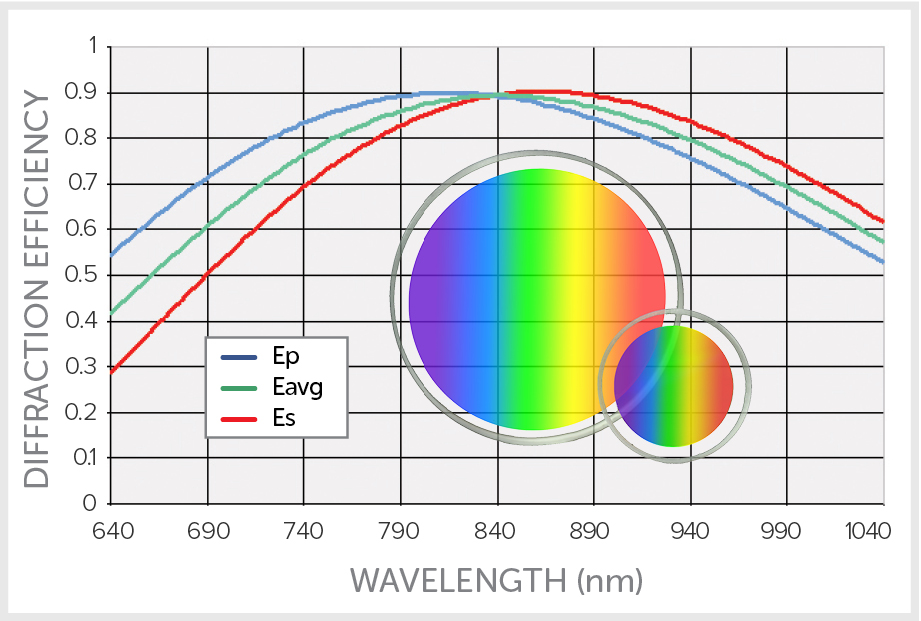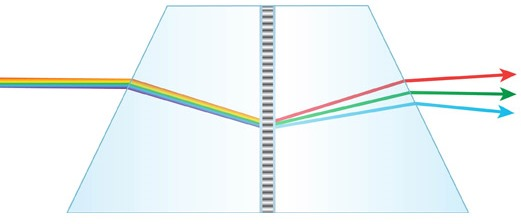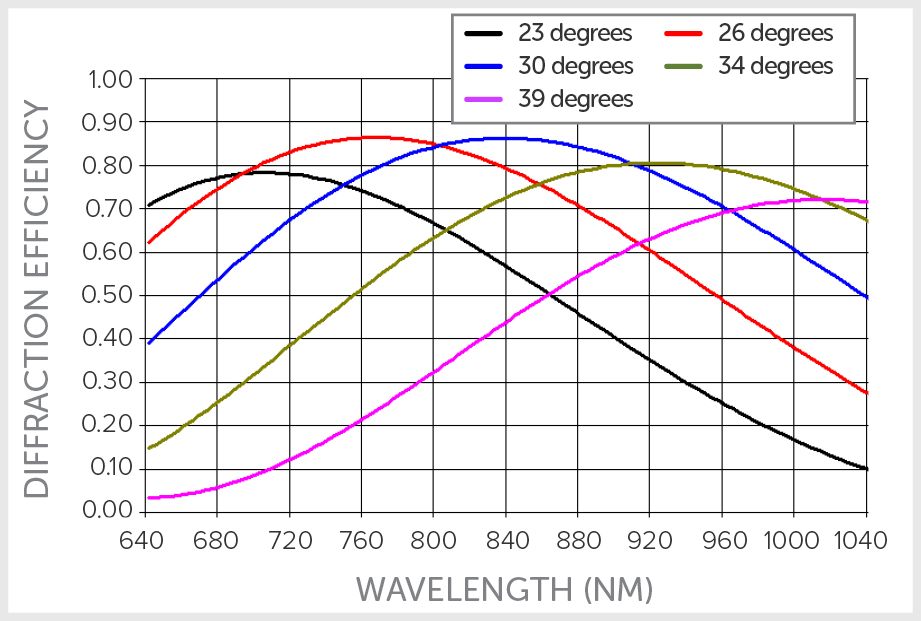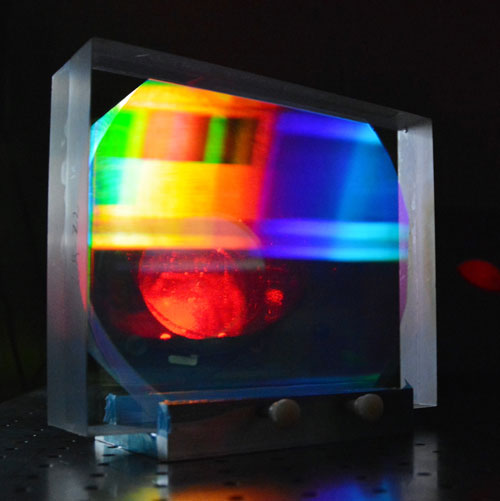Wasatch Photonics’ volume phase holographic transmission grating technology is at the core of the company’s work. This article explores the key benefits of using VPH gratings rather than standard reflective ruled gratings, outlining the best way to maximize the impact of these advantages.
VPH gratings’ advantages range from design flexibility and superior optical performance to consistency and robustness, with VPH gratings being well suited to applications such as spectroscopy, laser pulse compression, astronomy, and optical coherence tomography.
Each Grating is an Original
Wasatch Photonics produces volume phase holographic (VPH) transmission gratings by imaging a periodic structure of high and low index of refraction regions or areas into dichromated gelatin and sealing this between two optical windows.

This technique was first commercially utilized by IBM in holographic barcode scanners but was subsequently modified for use in a wide range of optical instruments and telecommunications technologies.
This process facilitates the manufacture of very high-quality diffraction gratings in volumes of 1 to 1,000 pieces, or higher if required. Because there is no original or primary grating to wear out during replication, consistent performance can be ensured from one grating to the next over extended periods with no degradation from copying.
Because the gratings are all originals, these can be customized or optimized, both easily and cost-effectively per application, for example, via adjustments in bandwidth, line density, polarization sensitivity, and other parameters. These adjustments can even be made in multiple iterations.
Peak Efficiency Curves
The holographic, transmissive nature of Wasatch Photonics’ VPH gratings facilitates their operation at high peak diffraction efficiencies from >80% at a 200-300 nm bandwidth to >99% at a single wavelength for Bragg conditions.
Their performance is up to 40% better than reflective surface relief gratings. Reflective surface relief gratings may possess jagged, asymmetric efficiency profiles that cause problems with system response. The efficiency of a VPH grating varies smoothly with wavelength, and this can be modeled during design for inclusion in system performance models before being reliably manufactured based upon that design.

VPH gratings are encapsulated, allowing for the application of high‐performance, anti-reflection (AR) coatings on the element’s surfaces. These coatings enable performance to be further optimized as well as being customizable as required for OEMs.
Multiple patented design technologies are employed to optimize each grating for the application in question. Three different design technologies are used to optimize gratings to a customer’s needs, ensuring uniform efficiency over the required bandwidth. Many stock gratings are available for online purchase for R&D and quick prototyping, while custom gratings can be designed for OEMs or unique one-off application needs.
High Dispersion
It is possible to reliably generate VPH gratings with higher line densities than ruled gratings, producing high-quality gratings with low scatter and ghosting at line densities ranging from 150 to near 6000 lines/mm.
These gratings can be used in applications as varied as high-resolution atomic spectroscopy and broadband NIR hyperspectral imaging, and the flexibility of the manufacturing process allows the line density and wavelength of operation to be customized with ease.
Reduced Polarization Sensitivity
Surface relief reflection gratings tend to offer far lower efficiency for p-polarization than s-polarization, and these will likely display very different efficiency responses between the two states.
This phenomenon is especially evident as the grating’s line frequency increases. VPH gratings are much less sensitive to polarization, with the extra advantage that their polarization response is both smoothly varying and well known.
Wasatch Photonics offers numerous design solutions, including the patented Dickson and HD gratings, which allow polarization response to be minimized and/or optimized on a per-application basis.
Compact, Flexible Optical Designs
Transmission gratings provide a straightforward means of making an optical design more compact because it is possible to design transmission gratings to work in the Littrow configuration (Ɵd = Ɵi). Generally, transmission gratings provide optical engineers with increased geometry options, whether they are designing a spectrometer or a pulse compression system.
Overall, systems built around a Wasatch Photonics VPH grating tend to be more compact, lightweight, and cost-effective than systems designed around a traditional reflection grating. They are also easier to align.
Grism
A grism is a grating sandwiched between a pair of prisms, and this compound optic can separate light into its components while simultaneously canceling out beam deviations caused by each element.

Grisms can be employed to create a straight pass dispersive optic or an optic with a higher dispersion than can be achieved with a grating alone. Grisms are commonly used in imaging, spectrally encoded confocal microscopy, astronomy, and other applications due to their convenience.
Angle Tuning
VPH transmission gratings diffract light using parallel regions of a sinusoidally varying index. This periodic structure results in the creation of a resonant structure that can be tuned in center wavelength by adjusting the angle of incidence (AOI) by up to ~10 °.

Varying the AOI in this way is common in astronomy, and allows a single grating to be angle-tuned to study spectral features of interest in various ranges. In some instances, a number of very large gratings on rotating stages may be utilized in a single large-scale telescope to continuously cover the visible through near-infrared regions.
Low Scatter, No Ghosting
Ruled gratings are highly prone to ‘ghosts’ – the name given to light artifacts that appear in the dispersion plane as a result of periodic ruling errors. It is possible to design VPH gratings to eliminate ghosting.
VPH gratings also have 90 % less stray light than their ruled counterparts, as well as exceptional spatial uniformity, and minimal transmitted wavefront error. All of these factors are key contributors to the outstanding first-order diffraction efficiency of VPH gratings.
Excellent Durability
The optically active segment of a VPH grating is sealed between two substrates. This creates a robust component, offering excellent environmental performance and thermal stability.
Many Wasatch Photonics gratings have been in active service for over a decade with no signs of degradation, while others were successfully deployed at near cryogenic temperatures. Wasatch Photonics gratings can be used in a diverse array of applications, from spectroscopy, laser pulse compression and biomedical devices through to astronomy.
Easy to Clean
Ruled, the reflective grating cannot be cleaned. Every fingerprint or speck of dust should remain present because scratching occurring from cleaning can be even worse than the contamination itself.
In contrast, encapsulated VPH gratings can be cleaned and handled like any other glass optical component, meaning they are far more manufacturing-friendly and cost-effective at every stage, from initial build through to extended use.
Size & Substrates – Big & Small
VPH gratings can be manufactured at much larger sizes than many people expect. Custom gratings are routinely manufactured up to 300 mm in size for astronomical spectrographs, and larger sizes can be manufactured on request. Gratings can also be cut down to as small as 8 mm in diameter for volume OEM applications.
Numerous types of glass materials can be utilized for manufacture, with the most common substrates being B270i, N-BK7 or equivalent, and fused silica (UV optional).

The quality of Wasatch Photonics’ optics has proven advanced interferometric measurement capabilities, ideal for critical applications such as laser pulse compression, astronomy, or optical coherence tomography. The company’s metrology lab even houses a new Zygo Verifire™, which is capable of measuring up to 4” optics.
Conclusion
Wasatch Photonics started to write volume phase gratings in dichromate gelatin more than 40 years ago because the company was confident that VPH grating technology could offer the performance, ability, and flexibility to scale from prototype to volume for a comprehensive range of applications.
Since then, Wasatch Photonics has strived to provide the consistent quality expected from an experienced volume gratings supplier.

This information has been sourced, reviewed and adapted from materials provided by Wasatch Photonics, Inc.
For more information on this source, please visit Wasatch Photonics, Inc.